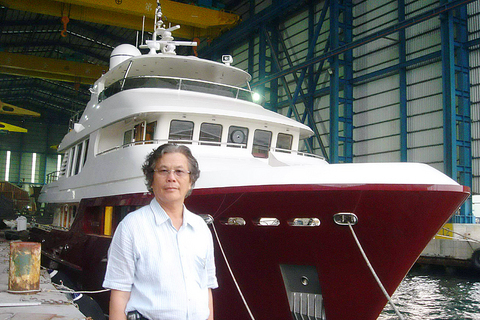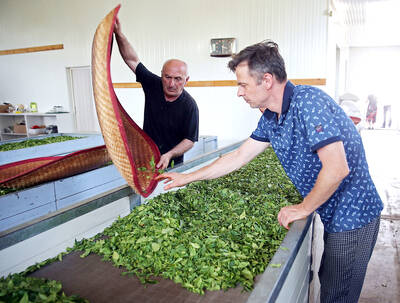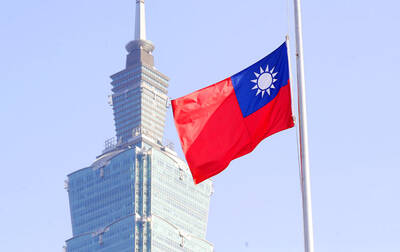Four years ago, Han Pi-hsiang (韓碧祥), chairman of the nation's largest private shipbuilder, Jong Shyn Shipbuilding Co (中信造船), attended a yacht launching ceremony in Italy, where large-sized steel super yachts attracted well-heeled buyers from around the world.
That ceremony left a deep impression on Han and led to the founding of Jade Yachts Shipbuilding Corp (高鼎遊艇), where he also serves as chairman, in 2003.
Starting as an apprentice at the age of 15 at a local shipbuilding factory, Han, 65, has become a legend in the industry with his vision and daring.

PHOTO: JESSIE HO, TAIPEI TIMES
Like semiconductors and flat-panel manufacturing, Taiwan is also a dominant player in the yacht-building market.
According to the Yachts International Global Build Report 2005-2006, Taiwan ranked as the fourth-largest contractor last year with orders for 49 yachts, behind Italy, the US and the Netherlands.
Taiwanese yacht builders mainly manufacture fiber-reinforced plastic (FRP) yachts, which are limited to 150 feet (45m) in length overall (LOA).
Jade Yachts, however, is currently putting the finishing touches on the first made-in-Taiwan steel super yacht -- the Bandido -- before its scheduled delivery on Saturday.
The 86-foot steel and aluminum hulled Bandido, built for Drett-mann GmbH, a German-based ship agent, got its first sea trial last Friday in Kaohsiung Harbor.
Prior to this, Jade Yachts made its mark by winning the contract for converting a 210-feet ship into a luxury yacht for a daughter of French fashion powerhouse Bernard Arnault, chairman and chief executive officer of LVMH Moet Hennessy Louis Vuitton SA
The deal was significant at the time because Jade Yachts, as a start-up, had no experience in making steel yachts. The firm outbid its rivals by offering to complete the contract at a cost of NT$30 million (US$914,000) and delivering the mega-project in two years.
Although the order was the highest ever clinched by a Taiwanese shipbuilder, the amount was 30 percent lower than other competing bids for the project, leaving Jade Yachts with very little profit margin.
"We took it as a great opportunity to learn and made it a head start for our future business," Han said.
Although the yacht -- with more than 10 suites, along with a gym, restaurant, swimming pool, movie theater, restaurant and other entertainment facilities -- was only 95 percent completed by Jade Yachts owing to some dispute with the owner, the resources and investment in the super yacht have paved the way for follow-up orders.
Besides pumping more than NT$800 million into a new shipyard, Jade Yachts invested heavily in acquiring a key technology for making steel yachts -- mirror painting.
To polish the hull of the yacht to a sleek mirror finish that is at least 90 percent reflective from a 600 angle, Han hired foreign specialists and consulted Superyacht Solutions International, an Australian firm, on technology transfer.
The result was remarkable.
"The Bandido that we are working on is an upscale European quality [model]," Dave White, a marine engineer atDrettmann, said on Friday in Kaohsiung Harbor.
The good start prompted Drettmann to place orders for another four ships.
Having worked with Taiwanese shipbuilders for 12 years on more than 30 boats, White said that Taiwan is well-positioned in the business given a favorable climate, hard-working laborers and high production flexibility.
Han said that Taiwan's comparatively lower labor cost is another crucial advantage, especially now that building costs in Europe are surging as a result of the euro's sharp appreciation in the past few years.
Right track
As steel yachts are getting more popular, Jade Yachts is on the right track, White said. The margin from making FRP yachts is declining given competition from China, making the transition to high-end products critical, he said.
According to statistics provided by Jade Yachts, on average, the building cost for mass-production, smaller FRP yachts measuring less than 33ft LOA are US$8,000 per foot, and that for larger FRP yachts between 33ft to 164ft is US$60,000 per foot.
Costs for custom steel yachts are way higher, ranging from US$600,000 per foot for ships measuring between 164ft and 230ft, to US$1.3 million per foot for top-grade vessels above 230ft, the company said.
Profit margins from the different types of yachts soar along with the costs.
But Taiwan still has room for improvement when it comes to building custom-designed yachts. One quality standard that needs to be emphasized is cleanliness, White said. Keeping a clean working area and staff are important when building yachts that cost more than US$10 million, he said.
The shortage of skilled workers is another obstacle that could limit growth in this market, White said.
Aware of the problem, Han said he has started to work with colleges and offered scholarships and internships for students in woodworking, design and related fields.
To aid the industry's shift to a higher-end market, Han called on the government's help in providing loans, land and tax incentives for shipbuilders.
Taiwan's high-tech sector has long been subsidized by the government, while the shipbuilding industry has to stand on its own feet for decades, he said.
Promoting yachting as a national pastime could further help the sector, Han said.
To achieve this, wharfs need to be constructed, Han said. Taiwan has none at present.
Once the infrastructure is in place, sailors from other countries anchoring in the wharves will bring in more cash for cleaning, maintenance, fuel and other services.
The government also needs to revise the Shipping Act (
Dream
At the end of the sea trial, asked how he would evaluate the first steel yacht he has built, Han gave a modest score of 80 out of 100 points.
"We always have room for improvement," Han said.
Yacht building may be a traditional industry, but it has an international perspective, Han said, adding that he hopes to make Jade Yachts a world-class brand name and a guarantee of quality.
While other traditional industries have moved to China, Han said he would maintain his roots in Taiwan.
"We will keep moving forward and improving our quality so that our Chinese competitors can never catch up," Han said.

When Lika Megreladze was a child, life in her native western Georgian region of Guria revolved around tea. Her mother worked for decades as a scientist at the Soviet Union’s Institute of Tea and Subtropical Crops in the village of Anaseuli, Georgia, perfecting cultivation methods for a Georgian tea industry that supplied the bulk of the vast communist state’s brews. “When I was a child, this was only my mum’s workplace. Only later I realized that it was something big,” she said. Now, the institute lies abandoned. Yellowed papers are strewn around its decaying corridors, and a statue of Soviet founder Vladimir Lenin

UNIFYING OPPOSITION: Numerous companies have registered complaints over the potential levies, bringing together rival automakers in voicing their reservations US President Donald Trump is readying plans for industry-specific tariffs to kick in alongside his country-by-country duties in two weeks, ramping up his push to reshape the US’ standing in the global trading system by penalizing purchases from abroad. Administration officials could release details of Trump’s planned 50 percent duty on copper in the days before they are set to take effect on Friday next week, a person familiar with the matter said. That is the same date Trump’s “reciprocal” levies on products from more than 100 nations are slated to begin. Trump on Tuesday said that he is likely to impose tariffs

ELECTRONICS BOOST: A predicted surge in exports would likely be driven by ICT products, exports of which have soared 84.7 percent from a year earlier, DBS said DBS Bank Ltd (星展銀行) yesterday raised its GDP growth forecast for Taiwan this year to 4 percent from 3 percent, citing robust demand for artificial intelligence (AI)-related exports and accelerated shipment activity, which are expected to offset potential headwinds from US tariffs. “Our GDP growth forecast for 2025 is revised up to 4 percent from 3 percent to reflect front-loaded exports and strong AI demand,” Singapore-based DBS senior economist Ma Tieying (馬鐵英) said in an online briefing. Taiwan’s second-quarter performance beat expectations, with GDP growth likely surpassing 5 percent, driven by a 34.1 percent year-on-year increase in exports, Ma said, citing government

HELPING HAND: Approving the sale of H20s could give China the edge it needs to capture market share and become the global standard, a US representative said The US President Donald Trump administration’s decision allowing Nvidia Corp to resume shipments of its H20 artificial intelligence (AI) chips to China risks bolstering Beijing’s military capabilities and expanding its capacity to compete with the US, the head of the US House Select Committee on Strategic Competition Between the United States and the Chinese Communist Party said. “The H20, which is a cost-effective and powerful AI inference chip, far surpasses China’s indigenous capability and would therefore provide a substantial increase to China’s AI development,” committee chairman John Moolenaar, a Michigan Republican, said on Friday in a letter to US Secretary of